Overview of the Global Anemia Problem, Including Iron Deficiency Anemia
The World Health Organization (WHO) defines anemia among women of childbearing age as the condition of having a hemoglobin concentration of < 12.0 g/dL at sea level; among pregnant women it is defined as < 11.0 g/dL. The hemoglobin concentration cutoff level that defines anemia varies by age, gender, physiological status, smoking status, and the altitude at which the assessed population lives.
The primary cause of anemia is iron deficiency, a condition caused by inadequate intake or low absorption of iron, the increased demands of repeated pregnancies—particularly if not well spaced (e.g., fewer than 36 months between pregnancies)—and loss of iron through menstruation. Other causes of anemia include vitamin deficiencies (such as a deficiency of folic acid or vitamin A), genetic disorders, malaria, parasitic infections, HIV, tuberculosis, common infections, and other inflammatory conditions. While iron deficiency anemia (IDA) accounts for about one-half of all anemia cases, it often coexists with these other causes.
Iron deficiency anemia is most common during pregnancy and in infancy, when physiological iron requirements are the highest and the amount of iron absorbed from the diet is not sufficient to meet many individuals’ requirements (Stoltzfus and Dreyfuss 1998). Anemia’s effects include increased risk of premature delivery, increased risk of maternal and child mortality, negative impacts on the cognitive and physical development of children, and reduced physical stamina and productivity of people of all ages (Horton and Ross 2003). Globally, IDA annually contributes to over 100,000 maternal deaths (22 percent of all maternal deaths) and over 600,000 perinatal deaths (Stoltzfus, Mullany, and Black 2004). Key anemia control interventions include promoting a diversified diet, iron-folic acid (IFA) supplementation during pregnancy, iron fortification of staple foods, prevention and treatment of malaria, use of insecticide-treated bed nets, helminth prevention and control, delayed cord clamping, and increased birth spacing.
Maternal Anemia in Nepal
The prevalence of anemia among pregnant women in Nepal is 48 percent, making it a severe public health problem as defined by WHO standards1 (MOHP, New ERA, and ICF International Inc. 2012). Regarding anemia severity, the majority of cases among pregnant and breastfeeding or non-pregnant women reported in the 2011 Nepal Demographic and Health Survey (NDHS) are classified as mild or moderate.2 Less than one percent of anemia cases among these groups of women are diagnosed as severe. Various health factors may cause or perpetuate anemia. In one study in the plains of Nepal, 73 percent of pregnant women were anemic (Dreyfuss et al. 2000). Of this group, 80 percent of anemia cases were associated with iron deficiency. Regarding the severity of anemia, the intensity of P. vivax malaria and hookworm infections were strongly associated with moderate and severe anemia (defined in the study as hemoglobin <9.0 grams/deciliter and <8.0 grams/deciliter, respectively). Seasonal variations in anemia during pregnancy have also been observed in Nepal. The prevalence of maternal anemia tends to be highest during and after the monsoon season (Jiang et al. 2005; Bondevik et al. 2000).
Falter Points in Women's Consumption of Iron-Folic Acid During Pregnancy
WHO recommends that all pregnant women receive a standard dose of 30–60 mg iron and 400 μg folic acid beginning as soon as possible during gestation (WHO 2012a). Ideally, women should receive iron-containing supplements no later than the first trimester of pregnancy, which means ideally taking 180 tablets before delivery. It is important to note, that many countries aim for women to receive 90 or more tablets during pregnancy.
Figure 1. Analysis of Falter Points Related to Distribution and Consumption of IFA through Nepal’s ANC Program in 2011, Women of Reproductive Age (15–49 Years) n = 12,674
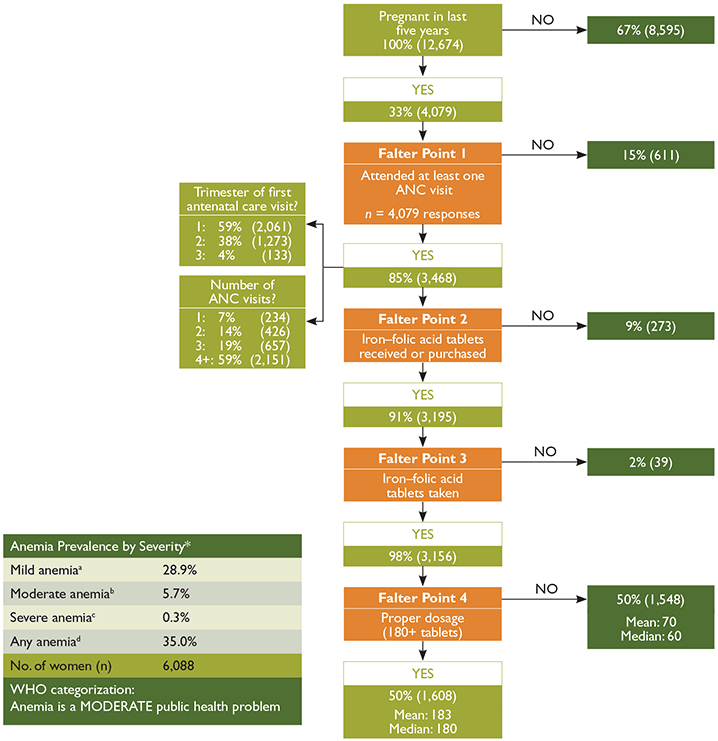
Main Conclusions: ANC has relatively high coverage and has significant potential for distributing IFA. Among women who were pregnant in the last five years, had at least one ANC visit, and took at least one IFA tablet, 50 percent received and took the ideal minimum number of tablets. Falter Point 4 is the most important constraint, though Nepal’s performance is strong compared with other countries. Both supply and demand considerations need to be investigated.
*Percent of women 15–49 based on Hemoglobin levels, Hb (g/dL)
aNPW 10.0≤Hb≤11.9, PW 10≤Hb≤10.9 bNPW 7.0≤Hb≤9.9, PW 7.0≤Hb≤9.9 cNPW Hb<7.0, PW Hb<7.0 dNPW Hb<12, PW Hb<11
Non-responses, no data were recorded to “No” for “At least one ANC visit?”, “IFA tablets received?” and “IFA tablets taken?” and to zero for “Number of tablets taken?”
Anemia prevalence data are provided as a reference point, signaling the general order of magnitude of the anemia public health problem. The ANC utilization data is based on self-reported data of women 15–49 years in permanent unions and pertains to their last pregnancy in the last five years prior to the DHS survey.
Source: Calculations and anemia levels are from the Nepal Demographic and Health Survey (2011).
Figure 1 on the following page shows a decisiontree analysis of how well the Nepali antenatal care (ANC) system distributes IFA, and identifies four potential points at which the system might falter (highlighted in orange). The figure tracks the number and percentage of women who obtained ANC, those who subsequently received and consumed at least one IFA tablet, and those who consumed the ideal minimum number of tablets.3 All data are based on NDHS questions that were asked of women who were in a permanent union and had been pregnant in the five years prior to being interviewed4 (MOHP, New ERA, and Macro International Inc., 2012).
Many supply-side aspects—including both adequacy of IFA tablet supplies and technical knowledge and practices of ANC providers—need to be considered when assessing how well an ANC program delivers IFA. In addition, Falter Point 4 in Figure 1 clearly shows that the provision of IFA tablets to a pregnant woman is a necessary but not sufficient condition for the woman to consume the tablets, particularly at the ideal minimum. Thus, demand-side factors also play a critical role in determining the coverage and effectiveness of this program. These include whether or not women seek antenatal care and the timing and number of visits, as well as the extent to which women are aware of the significance of anemia and IFA, ask for IFA tablets, and comply with the IFA regimen.
Understanding the relative significance of each falter point enables them to be prioritized for more in-depth analysis, providing a first step in an evidence-based approach to systematically improving the program. The DHS does not collect information on the number of IFA tablets received by women. In the case of Falter Point 4, this lack of data creates ambiguities that make it impossible to fully understand whether shortcomings of the system relate primarily to supply- or to demand-side factors. Despite this limitation, the decision-tree analysis presented in Figure 1 still enables prioritizing the falter points for more in-depth analysis and action at the national, district, and health center levels.
Analysis of Falter Points
Falter Point 1:
Did not attend at least one ANC visit
Only 15 percent of women did not obtain at least one ANC visit.
ANC’s relatively high coverage provides significant potential for providing IFA coverage.
Falter Point 2:
Did not receive or purchase at least one IFA tablet
Of the women with at least one ANC visit, nine percent did not receive or purchase any IFA.
This supply-side constraint may be due to various system/supply-side performance shortcomings which could reflect: (1) Inadequate supply (e.g., stock outs); (2) Provider knowledge; (3) Provider practices that would lead to failure to provide IFA. As Figure 2 shows, this is the third most important falter point among all pregnant women in Nepal.
Unfortunately, the NDHS does not report the source(s) of the IFA tablets women received or purchased, and there is a small percentage of women attending ANC who get IFA tablets from a different source. While only three percent of Nepali women who received or purchased IFA did not have any ANC visits (not shown), we cannot ascertain whether or not those who received ANC obtained their IFA from their ANC provider. It is likely, however, that women who attend ANC are more likely to be aware of, to value and to be inclined to also take IFA, regardless of where they obtain them. Thus we would expect there to be a high correlation between the number of women who had at least one ANC visit and those who received or purchased IFA, which is consistent with the data. Women who have one or more ANC visits and who did not receive any IFA, constitute a missed opportunity to reduce the risk of anemia among a high-risk population.
Falter Point 3:
Did not take at least one IFA tablet
Of the women who received IFA, two percent did not consume any tablets.
This demand-side constraint is small in Nepal and may be due to women not understanding the significance of anemia and/or the significance of IFA, which may reflect: (1) inadequate provider counseling and follow-up; (2) women’s beliefs about actual or possible side-effects; or (3) sociocultural factors.
Falter Point 4:
Did not consume 180 or more IFA tablets
Of the women who received and took IFA, 50 percent did not consume the ideal minimum of 180 IFA tablets.
This falter point is a combination of supply and demand-side factors. Figure 1 sheds some light on two possible causes of this Falter Point: 42 percent of women who received ANC began their care after the first trimester, and the 40 percent who had less than WHO’s recommended four ANC visits during their last pregnancy may have started their ANC too late or may not have had enough visits to receive 180 tablets (given IFA distribution protocols). Both of these are likely contributing factors, but further research is needed to establish their relative importance, as well as the significance of other possible causes.
Globally, research has found that other common causes of Falter Point 4 include: (1) providers do not have access to adequate supply; (2) women do not receive adequate tablets because they have little access to care, or start ANC late, or do not have enough ANC visits making it difficult to obtain 180 tablets (given IFA distribution protocols); (3) providers do not provide adequate counseling or follow-up; (4) women do not adhere to the regimen, which may be due to difficulty in remembering to take the tablets daily, not knowing all the tablets are necessary, fear of having a big baby, side effects, tablet-related issues (taste, size, color, coating, packaging/storage problem). Further research is needed to determine the specific reasons for this falter point in Nepal.
Analysis by Sociodemographic Variables and Trends over Time
A comparison of 2006 and 2011 NDHS data reveals several encouraging ANC trends: (1) the coverage of ANC increased from 73.8 percent to 84.8 percent (Table 2); (2) the timing of the first visit has improved; (3) the proportion of women who had the WHO-recommended minimum of four visits increased from 29.4 percent to 50.1 percent (Table 1); and (4) the percent of women with at least one ANC visit who took at least one IFA tablet increased from 59.3 percent to 79.5 percent (Table 2). These positive and pronounced trends have all contributed to the prevalence of anemia among women 15–49 years falling by 13 percentage points, from 48.4 percent to 35 percent, an impressive reduction of 28 percent (Table 3).
Table 1. Number and Timing of Antenatal Care Visits in Nepal, 2006 and 2011
| Indicator | 2006 | 2011 | Change in Coverage | Percentage Change |
|---|---|---|---|---|
| Number of ANC Visits | ||||
| Month of First Visit | ||||
| Median Months Pregnant at First Visit | ||||
| 0 | 26.2% | 15.2% | -11.0% | -42.0% |
| 1 | 8.5% | 6.1% | -2.4% | -28.2% |
| 2-3 | 35.8% | 28.6% | -7.2% | -20.1% |
| 4 + | 29.4% | 50.1% | 20.7% | 70.4% |
| No Antenatal Care | 26.2% | 15% | -11.2% | -42.7% |
| < 4 | 27.7% | 49.7% | 22.0% | 79.4 |
| < 6 | 28.9% | 26.1% | -2.8% | -9.7% |
| 6-7 | 14.1% | 7.4% | -6.7% | -47.5% |
| 8 + | 3.0% | 1.7% | -1.3% | -43.3% |
| Don't Know/No Data | < 0.1% | |||
| 4.6 | 3.7 | |||
Variations in coverage by residence are marked, with urban pregnant women more likely to receive ANC and IFA than their rural counterparts; however, rural areas have registered a greater change in coverage of ANC and IFA from 2006 to 2011. A considerable gap in coverage exists between women in the lowest and highest wealth quintiles: a difference of 21.8 percent in ANC coverage and 22 percent in IFA coverage (Table 2).
Table 2. Coverage of ANC and IFA Among Nepali Women 15–49 Years During the Pregnancy of Their Last Live Birth in the Past Five Years
| Characteristic | ANC Coverage | Change in Coverage | Took 1 + IFA Tablet | Change in Coverage | ||
|---|---|---|---|---|---|---|
| 2006 | 2011 | 2006 | 2011 | |||
| Subregion | ||||||
| Residence | ||||||
| Wealth | ||||||
| Eastern Mountain | 63.1% | 83.3% | 20.2% | 41.5% | 75.2% | 33.7% |
| Central Mountain | 68.2% | 77.7% | 9.5% | 59.2% | 72.0% | 12.8% |
| Western Mountain | 49.5% | 74.3% | 24.8% | 33.4% | 72.4% | 39.0% |
| Eastern Hill | 71.5% | 81.0% | 9.5% | 45.9% | 73.9% | 28.0% |
| Central Hill | 76.4% | 81.6% | 5.2% | 70.7% | 77.9% | 7.2% |
| Western Hill | 71.4% | 79.0% | 7.6% | 56.7% | 73.6% | 16.9% |
| Mid-Western Hill | 48.4% | 69.6% | 21.2% | 35.9% | 67.9% | 32.0% |
| Far-Western Hill | 68.7% | 89.7% | 21.0% | 45.8% | 86.4% | 40.6% |
| Eastern Terai | 88.1% | 92.8% | 4.7% | 73.0% | 88.9% | 15.9% |
| Central Terai | 76.2% | 84.1% | 7.9% | 61.1% | 76.4% | 15.3% |
| Western Terai | 66.6% | 94.2% | 27.6% | 50.6% | 87.0% | 36.4% |
| Midwestern Terai | 82.6% | 90.9% | 8.3% | 63.7% | 83.3% | 19.6% |
| Far-Western Terai | 88.8% | 96.9% | 8.1% | 78.5% | 95.7% | 17.2% |
| Urban | 87.9% | 93.8% | 5.9% | 74.9% | 88.9% | 14.0% |
| Rural | 71.6% | 83.9% | 12.3% | 56.9% | 79.5% | 22.6% |
| Lowest 40% | 60.5% | 74.0% | 13.5% | 44.3% | 69.5% | 25.2% |
| Highest 40% | 88.7% | 95.8% | 7.1% | 75.2% | 91.5% | 16.3% |
| National Average | 73.8% | 84.8% | 11.0% | 59.3% | 79.5% | 20.2% |
It is plausible that part of the substantial reduction in anemia in Nepal between 2006 and 2011 is attributable to the improvements in the distribution of IFA through ANC; as both ANC coverage and IFA coverage grew during that period (Table 2). ANC coverage increased by 11 percentage points and the coverage of IFA improved by 20 percentage points, a 34 percent increase.
Analysis by Geographic Regions within Country
The map in Figure 2 shows the percentage of women who had at least one ANC visit who reported receiving at least one IFA tablet by subregion. It shows consistently high percentages of women receiving IFA. The mean number of tablets women reported receiving and taking by subregion (not shown) is high compared with other low- and middle-income countries. Generally ranging from 50 percent to 85 percent of the ideal minimum of 180 IFA tablets, however, there remains room for improvement.
Figure 2. Percentage of Women Who Had at Least One ANC Visit and Received at Least One IFA Tablet by Subregion, Nepal, 2011
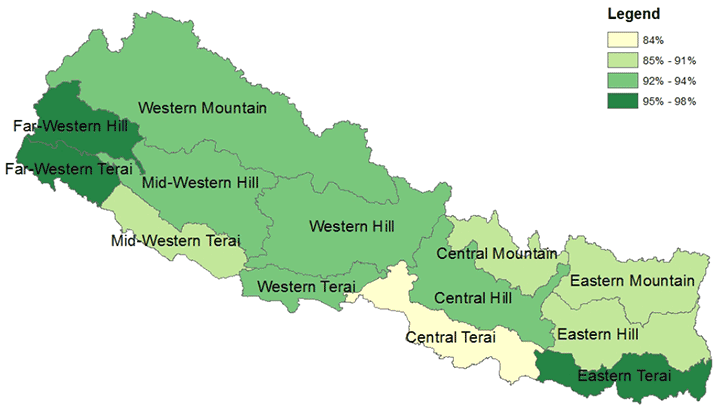
While the increases in ANC and IFA coverage in four of the five subregions of the Terai were less than the national averages, in part this was due to the Terai already having had higher ANC coverage and IFA coverage rates in 2006. As may be seen in Figure 3, in four of the five subregions of the Terai, the percentage of women who reported receiving 90 or more IFA tablets during their last pregnancy exceeded the national average, which may have contributed to the relatively greater reductions in prevalence of anemia in the Terai. Given that only 51 percent of women received and took 90 or more IFA tablets during their last pregnancy—just half the ideal minimum number—it is evident that improving the distribution of IFA through ANC still has a potentially substantial role to play in helping to further reduce anemia in Nepal.
Figure 3. Percentage of Nepali Women Who Received and Took 90+ IFA tablets, by Subregion, 2011
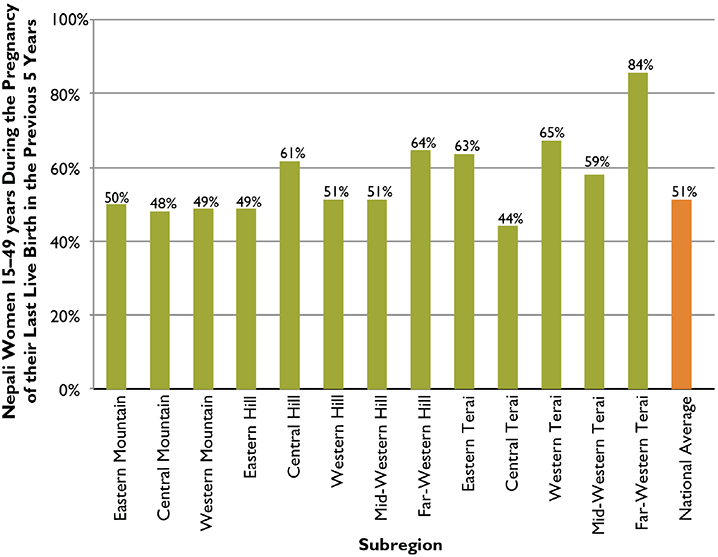
The prevalence of anemia varies significantly across Nepal’s three ecological zones and its 13 subregions (Table 3). It is lowest in the Hill zone (36.9 percent); intermediate in the Mountain zone (45.2 percent); and highest in the Terai (58.5 percent)(zone data not shown). There is also substantial variation within each of the zones, with the spread between the highest and lowest subregions differing by as much as 20 percentage points. Across Nepal’s thirteen subregions, anemia prevalence varies from relatively low levels in Central Mountain and Central Hill— where it averages 19 percent and constitutes a mild public health problem—to high levels of four in five subregions in the Terai, where it constitutes a severe public health problem, exceeding 40 percent.
Table 3. Changes in the Prevalence of Anemia among Nepali Women 15–49 Years, by Subregion
| Subregion | 2006 | 2011 | Change in Prevalence | Percentage Change |
|---|---|---|---|---|
| Subregion | ||||
| Eastern Mountain | 33.8% | 26.5% | -7.3% | -22% |
| Central Mountain | 32.4% | 19.2% | -13.2% | -41% |
| Western Mountain | 53.9% | 33.1% | -20.8% | -39% |
| Eastern Hill | 31.1% | 26.1% | -5.0% | -16% |
| Central Hill | 35.4% | 19.5% | -15.9% | -45% |
| Western Hill | 42.0% | 35.9% | -6.1% | -15% |
| Mid-Western Hill | 34.1% | 22.5% | -11.6% | -34% |
| Far-Western Hill | 41.3% | 28.8% | -12.5% | -30% |
| Eastern Terai | 49.4% | 44.9% | -4.5% | -9% |
| Central Terai | 62.9% | 42.6% | -20.3% | -32% |
| Western Terai | 60.8% | 32.7% | -28.1% | -46% |
| Midwestern Terai | 61.9% | 49.0% | -12.9% | -21% |
| Far-Western Terai | 59.6% | 41.9% | -17.7% | -30% |
| National Average | 48.4% | 35.0% | -13.4% | -28% |
Analysis by Number of ANC Visits
Figure 4 shows the relationship between the number of IFA tablets taken by women who had at least one ANC visit and the number of ANC visits they had during their last pregnancy. Women with more visits were generally likely to receive and take more IFA tablets, but only when the number of tablets received and taken was more than a quarter of the ideal minimum. Among women who had at least one ANC visit, 45 percent were taking 180 or more IFA tablets. Among those women who received IFA tablets and had four or more visits, 61 percent were taking the ideal number of IFA tablets.
Figure 4. ANC Distribution of IFA Tablets: Number of tablets Received and Taken According to Number of ANC Visits, Nepal, 2011
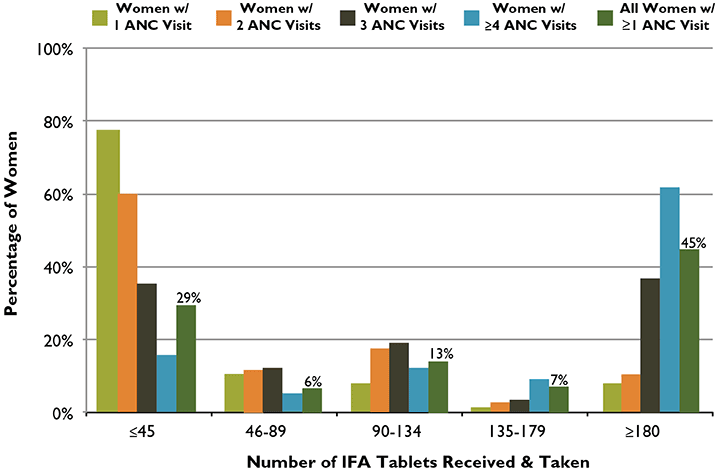
Overall Conclusions and Recommendations
Figure 5 presents the obstacles amongst all women, including those who did not receive ANC during their pregnancy, to taking the minimum appropriate number of IFA tablets. In Nepal, Falter Points 1 and 4 are the greatest barriers. Improving the delivery of IFA supplementation in Nepal relies primarily on increasing access to ANC (addressing Falter Point 1) but also on identifying and addressing program gaps in IFA supply management and health workers’ practices (to improve performance at Falter Points 2 and 4). Although Falter Point 4 is the most serious obstacle, Nepal has the lowest percentage of women who did not take the ideal minimum of 180 tablets among all countries reviewed, and likewise had the highest percentage of women who did not falter.
Figure 5. Relative Importance of Each Falter Point in Nepal: Why Women Who Were Pregnant in the Last Five Years Failed to Take the Ideal Minimum of 180 IFA Tablets
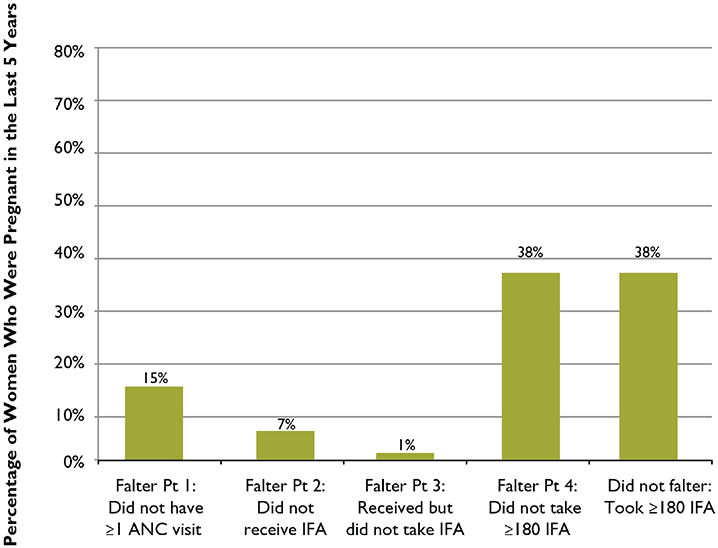
It is highly likely that the notable progress that Nepal has made in reducing anemia from 2006 to 2011 has contributed to the advances it has made in reducing its maternal mortality rate (MMR). Nepal’s MMR fell from 250 maternal deaths per 100,000 live births in 2005 to 170 in 2011, a reduction of 32 percent (WHO 2012b). This rapid assessment of the distribution of IFA through Nepal’s ANC program suggests that IFA may have already contributed to both of these encouraging trends, but it has also shown that there is still room for improvement in both the supply- and the demand-sides of the ANC program. It should be recognized that Nepal’s distribution of IFA through ANC is one of the most effective such programs in the world. However, more can and should be done. Improving the distribution of IFA through the ANC program is an important strategy to prevent and control anemia in Nepal, and to improve the nutrition and health status, as well as the mental and physical capacity of women of reproductive age.
Footnotes
1 The WHO categorizes the severity of anemia as a public health problem according to its prevalence: <5%, no public health problem; 5–19.9%, mild; 20–39.9% moderate; ≥40%, severe.
2 The DHS hemoglobin levels used to diagnose the severity of anemia in non-pregnant women are different than those specified by the WHO. The DHS cutoffs for pregnant and non-pregnant women in hemoglobin grams/deciliter are: Mild 10.0-10.9 (P) 10.0-11.9 (NP); Moderate 7.0-9.9 (P) 7.0-9.9 (NP); Severe <7.0 (P) <7.0 (NP); Any <11.0 (P) <12.0 (NP).
3 The NDHS asked about IFA tablets or capsules; this brief refers to all types as “tablets”.
4 The NDHS provides a population-based, nationally representative sample of all women in Nepal.
References
Bondevik, Gunnar T., Rolv T. Lie, Magnar Ulstein, and Gunnar Kvåle. 2000. “Seasonal variation in risk of anemia among pregnant Nepali women.” International Journal of Gynecology and Obstetrics 69(3): 215-222.
Dreyfuss, Michele L., Rebecca J. Stoltzfus, Jaya B. Shrestha, Elizabeth K. Pradhan, Steven C. LeClerq, Subarna K. Khatry, Sharada R. Shrestha, Joanne Katz, Marco Albonico, and Keith P. West, Jr. 2000. “Hookworms, Malaria and Vitamin A Deficiency Contribute to Anemia and Iron Deficiency among Pregnant Women in the Plains of Nepal.” Journal of Nutrition 130(10): 2527-2536.
Galloway, Rae. 2003. Anemia Prevention and Control: What Works. Washington, DC: USAID.
Horton, Sue and Jay Ross. 2003. “The Economics of Iron Deficiency.” Food Policy 28(1):51-75.
Jiang, Tianan, Parul Christian, Subarna K. Khatry, Lee Wu, and Keith P. West, Jr. 2005. “Micronutrient Deficiencies in Early Pregnancy are Common, Concurrent, and Vary by Season among Rural Nepali Pregnant Women.” Journal of Nutrition 135(5): 1106-1112.
Ministry of Health and Population (MOHP) [Nepal]. National Nutrition Strategy and Policy 2004. Nutrition Section, CHD, DoHS, MOHP.
MOHP [Nepal], New ERA, and Macro International Inc. 2007. Nepal Demographic and Health Survey 2006. Kathmandu, Nepal: Ministry of Health and Population, New ERA, and Macro International Inc.
MOHP [Nepal], New ERA, and ICF International Inc. 2012. Nepal Demographic and Health Survey 2011. Kathmandu, Nepal: Ministry of Health and Population, New ERA, and ICF International.
Stoltzfus, Rebecca J., and Michele L. Dreyfuss. 1998. Guidelines for the use of Iron Supplements to Prevent and Treat Iron Deficiency Anemia. Washington DC: ILSI Press.
Stoltzfus, Rebecca J., Luke Mullany, and Robert E. Black. 2004. “Iron Deficiency Anemia.” In Comparative Quantification of Health Risks: Global and Regional Burden of Disease Attributable to Selected Major Risk Factors, edited by Majid Ezzati, Alan D. Lopez, Anthony Rodgers, and Christopher J. L. Murray, 163-209. Geneva, Switzerland: World Health Organization.
World Health Organization (WHO). 2012a. Guideline: Daily Iron and Folic Acid Supplementation in Pregnant Women. Geneva, WHO.
WHO. 2012b. Indicator and Measurement Registry version 1.6.0. Maternity mortality rate. [August 28, 2012].